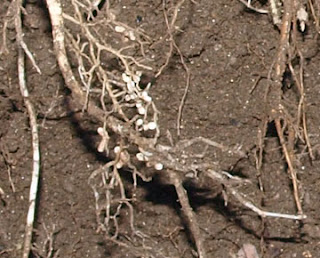To a large extent natural gardening depends upon the accumulation of biomass to increase fertility. You use nitrogen fixing plants to accumulate nitrogen and any fast growing plants to accumulate organic matter. Any area of the garden you don’t need for growing specific plants can be used to grow biomass. Sometimes this might mean planting suitable species, but it’s usually easier to simply allow native wild plants to grow themselves. You then cut (actually coppice) these periodically to provide biomass and to stimulate the plants to create more. Once you have cut the plants you have to decide how best to use all of the woody material thus created to benefit the garden.
The conventional way to deal with woody material it is to burn it. This is quick and fairly easy, but of course it destroys all of the organic matter that has been created and dissipates the nitrogen (it also creates air pollution). By doing this you defeat the whole purpose of growing biomass. All you are left with a small pile of concentrated plant nutrients (wood ash), which is great fertilizer, but nowhere near as valuable as what you vaporized.
f you have plenty of space another way to deal with woody material is to stack it into a pile and leave it for a few years to decompose naturally. However this takes a long time because brush is fairly resistant to decay. You need constant moisture for wood to decay and brushwood dries out rapidly when exposed to the air. You can speed up the decomposition markedly by creating a hugelkultur bed, whereby the brush pile is covered in a layer of soil, which keeps it moist all the time (a layer of nitrogen rich manure will further speed up the process). You can also make a berm of brush, covered with soil, to vary the garden topography.
Probably the best way to use brushwood is to run it though a chipper to turn it into mulch. All naturally inclined gardeners know that mulch is a very valuable garden material, which suppresses weeds, conserves soil moisture, protects the soil from the elements and provides nutrients as it decays. The problem with converting your brush into wood chips is that you need a chipper to do so, which usually means the expense of renting a big, smelly, noisy, highly polluting, dangerous (on more than one occasion the operator has simply disappeared, leaving the machine running), gas powered machine that isn’t much fun to use after the first 10 minutes. Electric chippers make much more sense as they are much lower maintenance, quieter (I didn’t say quiet), cleaner and easier to us. Unfortunately they tend to be underpowered and most people try them out a couple of times, decide they don’t really work and give up on them. I bought a small Lescha electric chipper for almost nothing at a tag sale (no doubt the original purchaser had done this) and after trying it I gave up on it for a long time. It sat around my shed for close to 10 years before my style of gardening changed and I discovered an effective use for it.
Before
1 hr later
No one in their right mind would attempt to chip woody brush with such a small machine as mine but that’s exactly what I do. Obviously it won’t chip a 3” branch (it wouldn’t even fit into the machine) so I trim the larger branches and separate out the smaller stuff for chipping. The neatly trimmed large stuff that remains is then used for fencing, rustic trellis, plant stakes and sticks to throw for the dog. It could also be used for the hugelkultur beds mentioned above, or even firewood. All of the smaller stuff (1” and less) goes into the chipper. Getting it through the machine requires a considerable amount of finesse though, as it’s easy to jam it, or stall and blow the circuit breaker. It took me a while to work out the proper approach, but with some persistence I eventually found that by feeding slowly, so as not to slow the motor too much, I could get it to work pretty well.
Once you get the woody biomass plants under control you can start harvesting them regularly (ideally when they are around 1” in diameter and can then go directly into the chipper) for use in increasing fertility.







